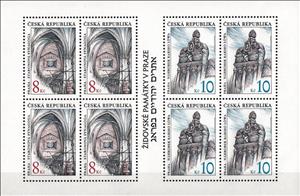Mini Sheet: Jewish monuments in Prague (Czech Republic 1997)
Jewish monuments in Prague (Czech Republic 1997)
30 April (Czech Republic ) within release Beauty of our homeland goes into circulation Mini Sheet Jewish monuments in Prague face value 72 Czech koruna
| Mini Sheet Jewish monuments in Prague in catalogues | |
|---|---|
| Michel: | Mi:CZ 142-143KB |
| POFIS: | POF:CZ A142-143 |
Mini Sheet is square format.
Stamps CZ-142 and CZ-143 were issued jointly by the one counter sheet. Therefore, the value of issue is for the counter sheets. CZECH-ISRAEL JOINT ISSUE OF COMMEMORATIVE STAMPS.Also in the issue Beauty of our homeland:
- Stamp - Jewish monuments in Prague - Old New synagogue face value 8;
- Stamp - Jewish monuments in Prague - Tombstone of rabbi Löwe face value 10;
- Mini Sheet - Jewish monuments in Prague face value 72;
Mini Sheet Jewish monuments in Prague it reflects the thematic directions:
A joint issue is the release of stamps or postal stationery by two or more countries to commemorate the same topic, event or person. Joint issues typically have the same first day of issue and their design is often similar or identical, except for the identification of country and value.A monument is a type of structure that was explicitly created to commemorate a person or event, or which has become relevant to a social group as a part of their remembrance of historic times or cultural heritage, due to its artistic, historical, political, technical or architectural importance. Examples of monuments include statues, (war) memorials, historical buildings, archaeological sites, and cultural assets. If there is a public interest in its preservation, a monument can for example be listed as a UNESCO World Heritage Site. The Palgrave Encyclopedia of Cultural Heritage and Conflict gives the next definition of monument:
Religion is any cultural system of designated behaviors and practices, world views, texts, sanctified places, ethics, or organizations, that relate humanity to the supernatural or transcendental. Religions relate humanity to what anthropologist Clifford Geertz has referred to as a cosmic "order of existence". Different religions may or may not contain various elements ranging from the "divine", "sacred things", "faith", a "supernatural being or supernatural beings" or "some sort of ultimacy and transcendence that will provide norms and power for the rest of life". Religious practices may include rituals, sermons, commemoration or veneration (of deities), sacrifices, festivals, feasts, trances, initiations, funerary services, matrimonial services, meditation, prayer, music, art, dance, public service, or other aspects of human culture. Religions have sacred histories and narratives, which may be preserved in sacred scriptures, and symbols and holy places, that aim mostly to give a meaning to life. Religions may contain symbolic stories, which are sometimes said by followers to be true, that have the side purpose of explaining the origin of life, the Universe and other things. Traditionally, faith, in addition to reason, has been considered a source of religious beliefs. There are an estimated 10,000 distinct religions worldwide. About 84% of the world's population is affiliated with one of the five largest religions, namely Christianity, Islam, Hinduism, Buddhism or forms of folk religion.
The United Nations Educational, Scientific and Cultural Organization (UNESCO; pronounced /juːˈnɛskoʊ/) is a specialized agency of the United Nations (UN) with the aim of promoting world peace and security through international cooperation in education, arts, sciences and culture. It has 194 member states and 12 associate members,as well as partners in the non-governmental, intergovernmental and private sector. Headquartered in Paris, France, UNESCO has 53 regional field offices and 199 national commissions




